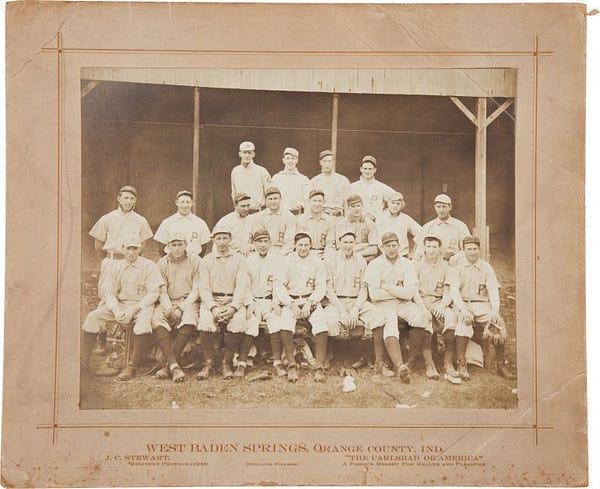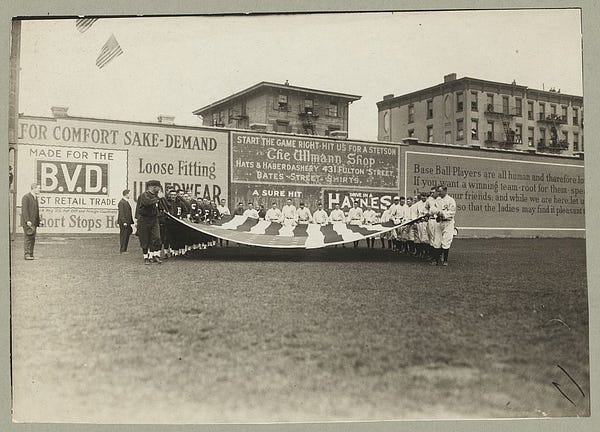Revisiting A 1915 Nailbiter Between A Federal League Team And A Semipro Squad
Today, we take a trip back over 100 years and work our way through a game that saw the Pittsburgh Rebels take on a semipro team in an exhibition game.
IBWAA members love to write about baseball. So much so, we've decided to create our own newsletter about it! Subscribe to Here's the Pitch to expand your love of baseball, discover new voices, and support independent writing. Original content six days a week, straight to your inbox and straight from the hearts of baseball fans.
An Opportunity To Get Involved
The Moonlight Graham Society is seeking public relations assistance to promote the first induction into its unique celebration of professional baseball. The MGS was founded in 2018 by three passionate baseball fans who lived their life’s dream by playing minor league baseball. Assistance would include traditional and social media outreach to sports news outlets. If interested please email baseballbytheseamedia@gmail.com.
Pregame Pepper
Did you know…
. . . The Pittsburgh Rebels was a member of the short-lived Federal League from 1913 to 1915. The team was originally called the Pittsburgh Stogies after an earlier Pittsburgh team that played in the Union Association in 1884 but then took on the Rebels name by the end of the 1914 season.
. . . Some Rebels players had experience in the American and National Leagues. Pitcher Cy Barger played two seasons with the New York Highlanders (later renamed the New York Yankees) and another three seasons with the Brooklyn Superbas-Dodgers before joining the Rebels. Fellow pitcher Howie Camnitz played for the Pittsburgh Pirates from 1904 until 1913 and was a member of their 1909 World Series team. First baseman Ed Konetchy played for the St. Louis Cardinals and the Pirates, before playing for the Rebels. After the team and the league folded in 1915, Konetchy continued his playing career with the Boston Braves, Brooklyn Dodgers, and Philadelphia Phillies.
Leading Off
Pittsburgh’s Federal Leaguers Needed Extras To Defeat A Semipro Squad
By Bill Pearch
With his team tied atop the Federal League standings, Pittsburgh Rebels player-manager Ennis Telfair “Rebel” Oakes faced a dilemma. After enduring a 10-5 loss to the Chicago Whales at Weeghman Park on Sunday, June 6, 1915, Oakes’ team had a week-long hiatus dubbed as “an odd turn of the schedule” by the Kansas City Star. Oakes pondered a strategy to keep his players sharp while they remained idle from regulation play. He arranged a series of exhibition games against teams of disparate talent along the Rebels’ route to Handlan’s Park and their next official game on the road against the St. Louis Terriers.
On Monday, June 7, the Rebels were knee-deep in the 1915 Federal League pennant race, tied with the Kansas City Packers. They were also in ankle-deep mud squaring off against the F.L. Smiths, a semiprofessional outfit from Dwight, Illinois.
Known primarily for the Keeley Institute’s unorthodox treatment of alcoholism, Dwight was the home of a baseball team owned and sponsored by Col. Frank L. Smith. Smith’s legacy is complicated. He served one term as a congressman and was chairman of the Illinois Commerce Commission. Following his election as an Illinois senator, Smith never assumed the role due to evidence of campaign fraud and corruption. At the time, he was a local banker with aspirations of earning the Republican nomination for Illinois’ 1916 gubernatorial election. As a devoted baseball fan, Col. Smith had a knack for attracting professional teams to his hometown’s West Side Park. Located approximately 60 miles southwest of Chicago, Dwight fell firmly within Oakes’ sights.
That afternoon, despite a fifty-cent price of admission, the biting wind and soggy conditions limited the crowd to a spattering of enthusiastic rooters. In its issue the following morning, the Pittsburgh Post noted that “the field was three inches deep with mud” which perhaps motivated Oakes to rest most of his regulars. Facing a squad of semipros, he assigned pitching duties to Charles Bunn “Bunny” Hearn. Hearn, a 24-year-old lefthander who bounced around various professional ranks since 1910, would oppose a 27-year-old righthander determined to sign another pro contract. Eddie Higgins, a Dwight native who enjoyed a fleeting stint with Roger Bresnahan’s St. Louis Cardinals in 1909 and 1910, handled mound duties for the locals.
Higgins demonstrated flashes of his days dominating the Three-I League as a rookie starting pitcher with the 1908 Bloomington (Illinois) Bloomers, but shoddy defense—ten errors—proved problematic. He blanked the Rebels until Steve Yerkes, starting second baseman and Rebels regular, crossed the plate courtesy of two singles and an error in the third inning.
Hearn’s last Federal League action came in a seven-inning losing effort against the Brooklyn Tip-Tops on May 26. Was he hamstrung by the adverse conditions? Maybe he underestimated his opponents as he surrendered five early runs with two in the first and three in the second. After composing himself, Hearn allowed an additional run in the bottom of the fourth inning.
Despite a five-run deficit, Oakes refused to make substitutions and jeopardize his regulars. Yerkes whittled away at the semipro’s lead and clubbed a two-run home run off of Higgins in the fifth inning. The F.L. Smiths maintained a 6-3 advantage while both teams hung zeroes on the scoreboard during the sixth and seventh innings. Third-string catcher Orie Kerlin, who debuted with the Rebels one day earlier against the Whales, singled off of Higgins. When third baseman Jimmie Savage stepped to the plate, he singled and plated Kerlin to make the score 6-4.
Three outs away from an improbable defeat, left fielder Cy Rheam singled to open the ninth inning. First baseman Hugh Bradley knotted the score at 6-6 when he hammered a Higgins fastball for a mammoth home run over the left-center field wall. The Rebels held the F.L. Smiths scoreless in the bottom of the ninth to force extra innings, and neither team plated a run in the 10th.
With two outs in the top of the 11th inning, Lewis reached first due to an errant throw. He proceeded to steal second base, then advanced to third on an O’Connor single. With Kerlin at the plate, Lewis and O’Connor attempted a double steal. Higgins tried to nail O’Connor at second base. Knight, Dwight’s shortstop, fired the ball home to nail the lead runner but his throw was low and skipped off of home plate and landed in the crowd. Both baserunners scored giving Pittsburgh its first lead of the game. Hearn sealed the F.L. Smiths’ fate in the bottom of the 11th inning to win, 8-6.
Although he benched a majority of his star performers, Oakes awoke to criticism from his home media. On June 8, the Pittsburgh Press chastised the manager’s plan noting that “the chances were too great to be taken with a club fighting for first place” in suboptimal playing conditions and the slightest mishap “might put one player out of the game for the remainder of the season.” Armed with that knowledge, Oakes’ team packed up and headed to Morris and Springfield, Illinois to close out the week.
Bill Pearch, a lifelong Chicago Cubs fan, serves as newsletter editor for SABR’s Emil Rothe Chapter (Chicago). He has contributed to SABR’s publications about old Comiskey Park, the 1995 Atlanta Braves, and is currently writing the biography of William Riddle “Doc” Marshall. Follow him on Twitter: @billpearch.
Extra Innings - Turn Back The Clock To 1915













